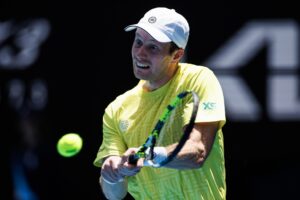There is more than one reason that Novak Djokovic is – by a distance greater than the one that separates them on the court – the least popular member of the ‘Big Three’. Some of that is due to his own missteps, much of it is not. But alongside the occasional poor decision and the gate-crashing of Roger Federer and Rafael Nadal’s duopoly, one of the reasons for his relative unpopularity is surely how easy his greatness can be to miss.
That is hardly a novel suggestion. Even this writer can admit that he is not the first to have noticed that Djokovic lacks the aesthetic qualities of Federer and the imposing physicality of Nadal. Merely by the overwhelming weight of his achievements the Serbian’s talent is recognised, but recognition is not the same as understanding: a ‘player’s player’ is never likely to capture the imagination of the crowd. Particularly in an era stocked that is still so generously stocked with stories and heroes even as it fades.
Perhaps, however, there is a simpler way of understanding what makes Djokovic a great player. He is simply better at nearly everything than nearly everyone else. The specifics of that advantage are relatively unimportant when it encompasses so many different areas of the game. That’s why he has been a part of so many epic matches and why he has won so many of them. It’s also why Denis Kudla can play an excellent match on his favourite surface and still lose in straight sets.
It’s an experience Kudla has endured before. In 2019, the American started his Championships with a 6-4 6-1 6-3 win over Malek Jaziri and was then brushed aside by Djokovic for the loss of only seven games. Kudla had his moments in that match and rather more of them in this one. In fact, for the first eight games of their most recent encounter, Kudla was the better player. Djokovic looked unsure of how to deal with the American’s flat, skidding groundstrokes and was caught out more than once by his willingness to use the drop shot.
In fact, it was only really Djokovic’s serve keeping him in it. But then that only points to the difficulty of the task. How do you beat a player who can beat you in so many different ways? Kudla did not find the answer. In the closing stages of the first set, Djokovic’s groundstrokes finally began to click and, in truth, the pressure of the moment told on Kudla. The Serbian, unsurprisingly also an excellent match player, broke immediately at the start of the second.
Kudla tried to come again. He broke back, only to surrender his serve again, before proving unable to take advantage of a second chance to get back on serve. But it was to no avail, despite a valiant effort from Kudla that brought the crowd into the match and a fearsome celebration from Djokovic. In the end, the gap in their respective abilities was simply too great for Kudla to bridge. Djokovic, even playing a poor match by his high standards, could withstand Kudla’s blows. The same was not true in reverse.
It lent the match an air of predictability that, for all the entertaining tennis played, robbed it of any true drama. Even when Kudla found a fresh spell of inspiration to win the first three games of the third set, his chances of winning the set, let alone the match still looked remote. Predictably enough, Djokovic found a way to get back on terms, breaking Kudla in the seventh game of the set.
To the casual observer, it seemed that Kudla had given the game away. Particularly as he hit two unforced errors to lose it having just saved two break points. To some extent that is what happened. But it was also the result of the pressure put on Kudla by Djokovic. The flaws in the American’s technique were exposed by the pressure of playing a man with almost none in his own. Kudla clung on to reach a tiebreak, but there the same flaws cost him.
Djokovic handed him an early head-start with two double faults, but Kudla could not quite take advantage. Wayward forehands and drop shots revealed the pressure that he was under. A pressure that he proved ultimately unable to cope with. Djokovic, in contrast, grew only more and more concentrated as the tiebreak wore on, eventually sealing the victory after an incredible point which showcased the very best of his defensive ability.
Kudla’s efforts were impressive, endearing and ultimately futile. The Serbian’s performance in the match was rather bad-tempered (although the handshake at the net was warm) and, at times, unfocused, an understandable response to a frustrating off-day. But it was also enough to secure victory. Because Kudla, like so many other players before him, was good but not quite good enough to overcome greatness.
Main photo:
Embed from Getty Images






